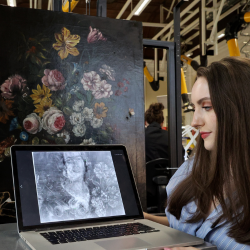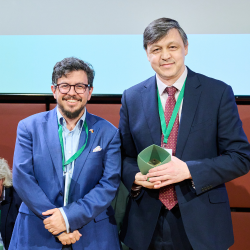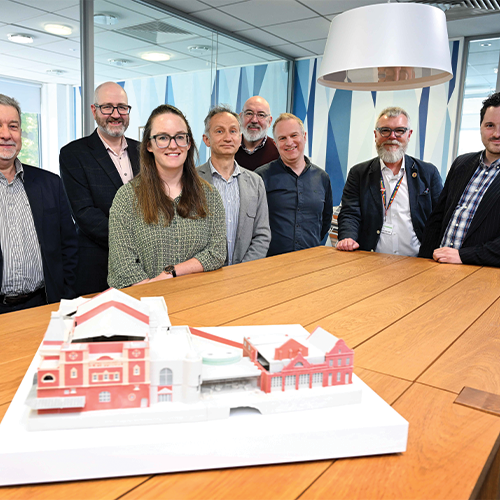Latest News and Features
More events
Upcoming events

Women鈥檚 Sport and Wellbeing Summit 2025
Lecture Theatre 003
-

NU Advice: Still time to apply
Virtual Event
-
They are too small to see with the naked eye, but microbes make up the vast majority of life on Earth – found in the soil, water and air around us, as well as inside our bodies.
Tiny, single-cell organisms, precursors to modern bacteria, were the earliest form of life on Earth, estimated to have first appeared around four billion years ago.
And yet despite their prevalence in our lives, there is still a mystery surrounding early bacterial evolution – specifically, why most bacteria have two membranes surrounding their single cell, whereas the cells in almost all other life forms have just one main membrane.
Scientists are unsure if the first bacteria on Earth had a single membrane and then evolved to develop the second, or if it was the other way round and the double membrane microbes evolved to create cells with a single membrane.
Due to the vast expanse of time which has passed since this evolution occurred, and a lack of fossilised samples as would be found for larger organisms, it has been very difficult to answer this important question in the journey of life on Earth.
But a new research project being carried out by microbiologists from Northumbria University’s Department of Applied Sciences could provide new insight into this early evolutionary mystery.
Professor Iain Sutcliffe and have been awarded a share of £12 million of funding provided by the to support projects which have the potential to transform our understanding of the rules of life.
The aim to draw upon unconventional thinking and approaches, funding new investigations which aim to radically change the way we think about important biological phenomena covering plant, microbial and animal sciences.
Professor Sutcliffe and Dr James' project, entitled A testable hypothesis for lipoprotein-driven bacterial outer membrane evolution, will involve attempting to recreate events that may have occurred during early evolution in a laboratory environment in order to discover how microbes developed a double membrane.
 Speaking
about the research, Professor Sutcliffe said: “When we think about
evolution and biology it tends to be in relation to the
conservation of large mammals such as elephants and pandas, or the
evolution of humans. But most life on Earth is microbial and single
cell microbes dominate all the biological processes on our planet.
Therefore, understanding how bacteria evolved will fill a gap in
our understanding of evolution and how life on Earth has changed
over billions of years.”
Speaking
about the research, Professor Sutcliffe said: “When we think about
evolution and biology it tends to be in relation to the
conservation of large mammals such as elephants and pandas, or the
evolution of humans. But most life on Earth is microbial and single
cell microbes dominate all the biological processes on our planet.
Therefore, understanding how bacteria evolved will fill a gap in
our understanding of evolution and how life on Earth has changed
over billions of years.”
Professor Sutcliffe’s research focuses on understanding the ‘envelope’ or outer layers of a bacterial cell. He has previously carried out a survey of different bacterial groups, which revealed that the vast majority have two membranes – one likened to the rubber of a balloon (although less prone to popping), then another waxy layer outside of that.
As he explains: “This was an interesting finding and gave us two options to consider – did the first ever cells have two membranes, but then some bacteria lost one during evolution? Or did the first cells only have one membrane and then the bacterial cells with two membranes develop from those? We can test these theories in the laboratory by starting with a bacteria with one membrane and, hopefully, engineering it to develop the outer membrane.”
To carry out the research, Professor Sutcliffe and Dr James will attempt to recreate a situation in the laboratory that could mimic what happened billions of years ago on Earth when microbial evolution was taking place.
As Professor Sutcliffe explains: “It is likely that the early world, going back three or four billion years, was a harsh environment. While human body temperature is 37 degrees centigrade, the organism we’re using to carry out our modelling grows at 55 degrees centigrade, or even hotter, so we will ensure it remains at that temperature as these may be more like the conditions under which it originally evolved.”
The Department of Applied Sciences has an exciting and extensive portfolio of subjects including biology, biomedical sciences, chemistry, forensic science, food and nutritional sciences.
BioFutures explores and exploits molecular biosystems to develop transformative solutions for a more sustainable and healthy society.
Our academics working in microbial biotechnology explore and exploit microbial systems to develop transformative solutions for a more economically and environmentally sustainable society.
This is the place to find all the latest news releases, feature articles, expert comment, and video and audio clips from Northumbria University
Northumbria University News is packed full of news and features covering everything from research projects and business partnerships to student and staff awards.

Two PhD researchers from Northumbria University have been awarded Venice Fellowships by the…

Northumbria University has unveiled a new state-of-the-art X-ray radiography instrument 鈥� an…

A biodegradable battery developed by researchers at Northumbria University has won a major…

On Thursday 22nd May, Innovate UK marked 50 years of Knowledge Transfer Partnerships (KTPs)…

A trailblazing education programme that has its origins in North East England is being rolled…

Northumbria University has once again cemented its reputation as a leading institution providing…

This week AHRC Creative Communities announced three major project outputs, with the creation…

Northumbria University鈥檚 Professor Glyn Howatson will be playing a key role in the next national…

Lecture Theatre 003
-

Virtual Event
-
Back to top